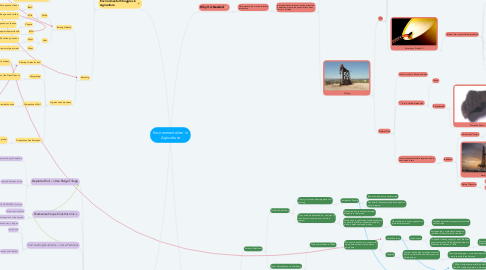
1. Environmental Struggles in Agriculture
1.1. Mixed Crop and Livestock Farming
1.1.1. Soil Erosion
1.1.1.1. Nutrient Degradation
1.1.1.1.1. Farms have several techniques to combat degradation
1.1.1.2. Loss of Fertility
1.1.1.2.1. Affects crop production
1.1.1.3. Blocks Waterways
1.1.1.3.1. Sedimentation of rivers and streams
1.1.1.4. Increased chance of flooding
1.1.1.4.1. Soil is less able to absorb and hold water
1.1.1.5. Topsoil
1.1.1.5.1. Contains most of the nutrients needed for crops
1.1.2. Water Pollution
1.1.2.1. Pesticides and fertilizers
1.1.2.1.1. Enter water streams
1.1.2.1.2. Enter the ocean
1.1.3. Deforestation
1.1.3.1. Clear forests for land
1.1.3.1.1. Livestock
1.1.3.1.2. Crops
1.1.4. Covers over 2.5 billion hectares of land
1.2. Ranching
1.2.1. Raising livestock
1.2.1.1. Cattle
1.2.1.1.1. Beef
1.2.1.1.2. Milk
1.2.1.1.3. Cheese
1.2.1.2. Goat
1.2.1.2.1. Milk
1.2.1.2.2. Wool
1.2.1.2.3. Meat
1.2.2. Impacts on environment
1.2.2.1. Clearing forests for land
1.2.2.1.1. 20% of the Amazon Rainforest has been cleared for cattle ranching
1.2.2.2. Overgrazing
1.2.2.2.1. A threat throughout the Great Plains of America
1.2.2.3. Compaction of Soil
1.2.2.3.1. This occurs from animal hooves
1.2.2.4. Greenhouse Gas Emissions
1.2.2.4.1. Ranching is a main contributor to global warming
2. Why It is Needed
2.1. Help prevent too much extractive economies
2.1.1. Resource-based economies dependent on harvesting or extracting natural resources for sale or trade
2.1.1.1. Mining
2.1.1.1.1. Gold
2.1.1.1.2. Copper
2.1.1.1.3. Diamond
2.1.1.1.4. Other Gemstones
2.1.1.1.5. Cons
2.1.1.2. Drilling
2.1.1.2.1. Oil
2.1.1.2.2. Natural Gas
3. Rainforest Agriculture
3.1. Amazon Rainforest
3.1.1. Swidden Agriculture
3.1.1.1. Burning of land to clear vegetation for farming
3.1.1.1.1. Indigenous People
3.1.1.2. Once nutrients were used up, new plot of land burned and previous one left to regrow
3.1.1.2.1. Necessary due to nutrient recycling efficiency in rainforests
3.1.1.2.2. Study done in rainforests used phosphorus to show that 99% of nutrients absorbed within a week from dead matter
3.1.2. Mass Deforestation via Machinery
3.1.2.1. Took over swidden in 1960's
3.1.2.1.1. Economic benefit led to commercial agriculture instead of subsistence agriculture
3.1.2.2. Today, only developing regions have forest left to exploit
3.1.2.2.1. Developed regions used resources to obtain goods from rainforests for economic development
3.2. African Rainforests
3.2.1. Subsistence Agriculture
3.2.1.1. Most deforested land owned by communal societies
3.2.1.1.1. Clear forested areas as needed by community
3.2.1.1.2. Need for food outweighs harmful effects of deforestation
3.2.2. Environmental Detriments
3.2.2.1. Agricultural malpractice such as long-term monoculture (planting only one crop repeatedly) leads to soil erosion and infertility past point of recovery
3.2.2.1.1. As a result, more deforestation occurs to clear more farmland
3.3. Southeast Asian Rainforests
3.3.1. Non-Timber Goods - account for majority of economic exploitation of Southeast Asian rainforests
3.3.1.1. Rattan
3.3.1.1.1. A fiber made from palm used for furniture
3.3.1.2. Exotic creatures
3.3.1.2.1. In Bangkok, Thailand, over 68,654 tropical birds were sold within just 25 weeks
3.3.2. Deforestation Effects
3.3.2.1. Mass deforestation forces this region to import more timber than they export/extract from forests
3.3.2.1.1. Logging can damage non-timber products
3.3.2.1.2. Mountainous regions of deforestation result in excess water runoff
4. Adaptations in Agriculture
4.1. Depleted Soil --> Use Ridge Tillage
4.1.1. prevent topsoil depletion
4.1.1.1. plant crops on ridge tops
4.1.2. intervals between crops
4.1.2.1. Example of ridge tillage
4.1.3. maximize SOIL NUTRIENTS for crops
4.2. Biodiverse Crops: Click this link
4.2.1. improve soil quality
4.2.2. various species of crops grown
4.2.2.1. less resistance to pesticide
4.2.2.1.1. less susceptible to disease
4.3. Soil Lacking Nutrients --> Use Fertilizer
4.3.1. potassium, phosphorus, nitrogen
4.3.2. enrich soil
4.3.3. issues with fertilizer
4.3.3.1. UNEQUAL ACCESS in DCs
4.3.3.2. monopoly of China
4.3.3.2.1. owns most of the nitrogen-based fertilizers in the global market
4.3.3.3. prices increasing as fossil fuel demands also go up
4.4. Unstable Water Supply --> Use Irrigation
4.4.1. using channels to direct water
4.4.1.1. places like India fluorished
4.4.2. helps supply lands during dry seasons too
4.5. Genetically Modified Crops
4.5.1. less sensitive to light
4.5.1.1. can be grown in longer periods
4.5.2. use less resources for same yield
4.5.2.1. INCREASE FOOD SUPPLY
4.5.2.1.1. possibly end world hunger? but,
4.5.2.2. can grow faster too
4.5.3. Here's an interesting video on the heated debate over GMOs
4.5.3.1. uncertain health consequences
4.5.3.2. questions over labeling
4.5.3.3. dominance of MNCs on DCs
4.5.3.3.1. large companies might reap all benefits
4.5.3.4. ethics over usage
4.5.3.4.1. religious and moral questions
4.5.3.5. may decrease biodiversity
4.5.4. MORE PRODUCTIVE
4.5.4.1. miracle seeds that grow stronger
4.5.4.1.1. more nutritious and faster growing
4.6. Organic Farming
4.6.1. MINIMIZE ENVIRONMENTAL HARM
4.6.1.1. SUSTAINABLE METHODS of agriculture
4.6.2. controversy
4.6.2.1. animal welfare
4.6.2.1.1. treatment of animals in farms and ranches
4.6.2.2. antibiotics use
4.7. Leaving land to "fallow"
4.7.1. short, bush, forest
4.7.1.1. clear fields and wait for vegetation to grow back in the designated area
4.7.2. cropping
4.7.2.1. annual- rotate between legumes, roots
4.7.2.2. multi- never leave fields to fallow
4.7.3. improving productivity, especially when limited resources or natural disasters
